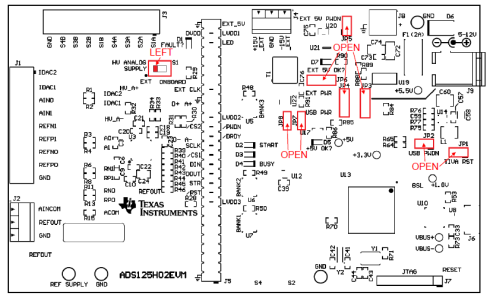Other Parts Discussed in Thread: ADS125H02,
Hello team,
my customer is using the EVM as the following setup:
whereas the jumpers are as in the following picture:
Finally this is the status of the ADC registers that I changed from the default values:
MODE4 (0x10) = 0x05 -----> Input Multiplexer = AN1-AN0 ; PGA Gain =0,5V/V
REF (0x06) = 0x03 -----> Internal Referance DISABLE ; Reference Positive Input =AVDD =+5V ; Reference Negative Input =AGND
The ADC does not seem to be so accurate: by measuring the same voltage with an external 4 1/2 digit multi-meter I noticed about 3 / 4mV of deviation), is it normal ?
I then tried to perform a calibration with the OFSCAL and GANCAL commands. I would like to understand if the procedure I do is correct:
- short circuit AN1 with AN0 leaving AN0 grounded (as shown in the figure below) and send the OFCAL command from the console
- then I connect AN1 to the + 5V of the card (which based on the setting of the registers represents the VREF and therefore the full scale of the ADC) and send the command GANCAL from the console
2) At the end of the OFCAL command actually the ADC adjusts the reading correcting the zero while at the end of the GANCAL command the ADC adjusts the reading correcting the full scale, but if at this point I go back to reading the zero I find it again moved away as if the GANCAL command had also influenced the offset. How is this possible ??
3) Is there an additional command that I have to send after the OFSCAL and GANCAL commands to confirm the calibration ??





